The ASUS Vivobook Pro 15 OLED Review: For The Creator In All Of Us
by Brett Howse on March 7, 2022 8:30 AM ESTDisplay Analysis
OLED is right in the name of the product, and it is certainly one of the key differentiators with the Vivobook Pro 15 notebook. OLED of course stands for Organic Light Emitting Diode which is a completely different display technology than the traditional Liquid Crystal Display (LCD) that the vast majority of notebooks employ. OLED has some major advantages over LCD which have translated into it dominating the smart phone market, as well as being the best option for televisions, but it has most certainly not won over the PC space.
Probably the biggest single advantage of OLED is that it offers an (effectively) infinite contrast ratio. Unlike an LCD light which uses filters to block a white LED backlight, OLED pixels themselves are the light source and can be turned off completely which means OLED offers a much deeper black level than any LCD can achieve. In addition, the OLED subpixels can generally offer a wider range of colors than most LCDs. OLED can also be very stingy with power when displaying black or dark images or graphics. In the smartphone world, most top-tier phones are now OLED and offer a dark mode enabled by default to reap the benefit.
OLED does have drawbacks though, and they can be significant for a laptop computer. While power draw when displaying darker content is an advantage, when displaying bright or white images or graphics the power draw of OLED can exceed an LCD at the same brightness. OLED also suffers from issues with burn-in, as the subpixels themselves age over time with use, and in an uneven fashion depending on the color.
To combat this, the OLED panel manufacturers will vary the size of the subpixels. Blue ages the quickest, so the blue subpixel is the largest to compensate. This also means there are fewer blue subpixels than red and green, so there will not be the same resolution across all of the colors.
The panel underlying the Vivobook Pro 15 OLED is a Samsung AMOLED part, which other sources have pegged as the ATNA56YX03-0. This means it's a true RGB panel, without any kind of color filters (ala WOLED), similar to Samsung's phones.
Switching to the software side of matters, Windows 10 offers a dark mode, and ASUS has included their own tweaks to take advantage of OLED’s strengths, but in the PC world a significant amount of software still defaults to a light theme, which can create a higher power draw on OLED versus LCD. That, coupled with the burn-in of often static content being displayed have certainly slowed the adoption of OLED in the laptop space.
The display in the Vivobook Pro 15, again, thanks to its OLED roots, offers a wider color gamut than a typical laptop as well. The Vivobook Pro 15 is marketed with DCI-P3 color support, although that is technically incorrect, as what it offers is actually P3 D65 color support – DCI-P3 is a cinema standard with a different white point. It is hard to fault ASUS here since most companies make the same mistake, but all we can do is point out the error when we see it.
The Vivobook’s OLED display also supports HDR, and is DisplayHDR True Black 600 certified, which is VESA's highest tier for OLED displays. Thanks to the high contrast, performing HDR on an OLED display is much easier than on an LCD where you need a very bright backlight to compensate for the high black levels of LCD displays.
Both P3 gamut support and HDR are advantages over most other notebooks. Or at least they should be. Sadly, Windows does not offer great support for either HDR or wider than sRGB color spaces. There is no native color management system in Windows which will display sRGB content at the correct color levels on a wider than sRGB display, which means the colors will be over-saturated unless you are using a properly color-managed application such as Adobe Photoshop. That means most content you look at on this notebook will be the oversaturated. That is a sad thing indeed, because the OLED display does look amazing.
ASUS does offer an included ICC color profile as well, and the device is Pantone Validated for color accuracy, but that is for the P3 gamut of course. The display also reduces blue-light emissions by 70% from some value that is not provided.
The Vivobook 15 Pro offers a glossy display which does help with avoiding the haziness of a matte finish, but ASUS has not added any sort of anti-glare coating, so the Vivobook Pro 15 is very reflective. This is an area where most PC manufacturers need to up their game. Dell has some wonderful anti-glare coatings on their XPS lineup, but most glossy laptops offer none.
To see how the ASUS Vivobook Pro 15 OLED display performs, it was run through our display testing. For brightness levels and contrast, the X-Rite i1Display Pro colorimeter is used, and for color accuracy testing, the X-Rite i1Pro 2 spectrophotometer takes the stage. As always, thanks to our friends at Portrait Displays for their Calman software suite which we utilize with a custom workflow. As always, we test all displays at 200 nits brightness.
Brightness and Contrast
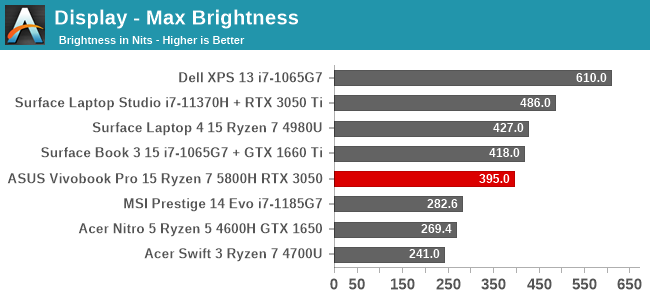
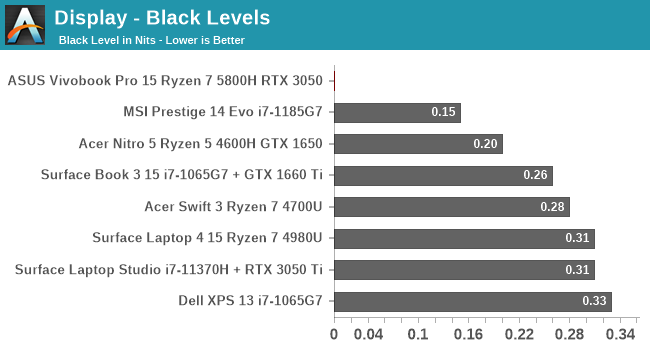
Despite the 15.6-inch OLED display, the Vivobook Pro 15 still gets quite bright at almost 400 nits. ASUS claims it can peak at 600 nits brightness which will be for a much smaller section of the display than the full-screen white we test on. The display also has a very wide range of brightness, going all the way down to 4.6 nits at 0%.
As far as contrast, it is basically infinite thanks to the OLED display being able to turn off the subpixels completely. Case in point: our meter read 0 nits on the black frame in our test workflow. We normally have a graph for contrast, but when the maximum brightness of 395 nits was divided by 0 nits, strange things happened, so that graph will have to be skipped for this review.
Grayscale Accuracy

Although ASUS includes an ICC profile, they appear to be calibrating the laptops in batches, which means the color correction is not finely tuned to the individual panel. We generally consider a device with a dE2000 under 3.0 to be considered accurate, and for most of the range the Vivobook OLED does fall under 3.0, but then around 65% brightness the error levels start to creep up as the red levels go too high. The average is just over 3.0, so this is still an accurate display, but the error level at 100% is significant. That is why we always include the entire graph.
Other than near the 100% level, the gamma value does follow the 2.2 power pretty accurately.
Gamut Accuracy
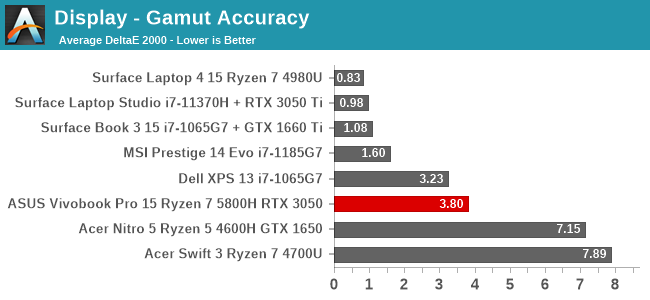
As previously discussed, this notebook targets the P3 D65 gamut rather than sRGB. Overall it is able to achieve that level, although cyan is well past its target. The average error level of 3.8 is quite good, but again points to a batch-corrected display rather than individual panel calibration.
Saturation

Unlike the gamut test which measures the primary and secondary colors at their 100% levels, the saturation test measures them at 4-bit steps across 0-100%. This shows that across most of the sweep, the color accuracy of the Vivobook Pro 15 OLED is quite good, and the Cyan issue seen in the gamut test happens only when the display is getting close to 100% levels for that color. Yellow is actually the least accurate color for most of the range.
Gretag Macbeth
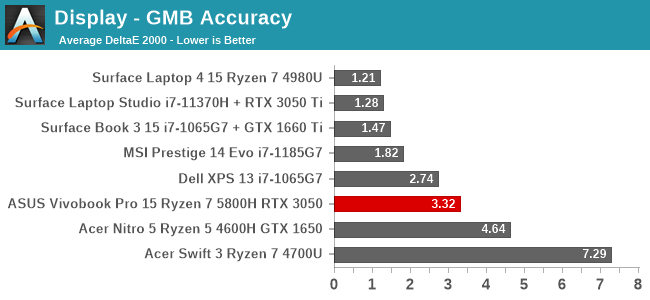
Where the saturation test measures the primary and secondary colors, the Gretag Macbeth test targets random colors form across the spectrum, including the important skin tones. The error levels here are quite significant on many of the colors, although the overall average is still quite good.
Colorchecker
Finally we have the colorchecker swatch, which shows the target color on the bottom of the image and the achieved color on the top of the image. This is a relative test as any inaccuracies in your own display will skew the result, but very much shows how the Vivobook Pro 15 biases towards red.
Display Conclusion
In a world where OLED has become much more common thanks to it being prevalent in the smartphone space, it is still special to see it in a notebook. This is not a perfect implementation, but the insane contrast just never disappoints. Sadly Windows still does not handle non-sRGB color gamuts very well, so even though ASUS has done a reasonable job calibrating the display, most of the time the color accuracy will be terrible unless you are using a color managed application.
Considering the price point of this laptop, it is one of the least expensive ways to get into an OLED laptop. As long as you are aware of the downsides of OLED with its possible burn-in issues and the P3 gamut causing overblown colors for most software the Vivobook Pro 15 OLED display is a stunner.


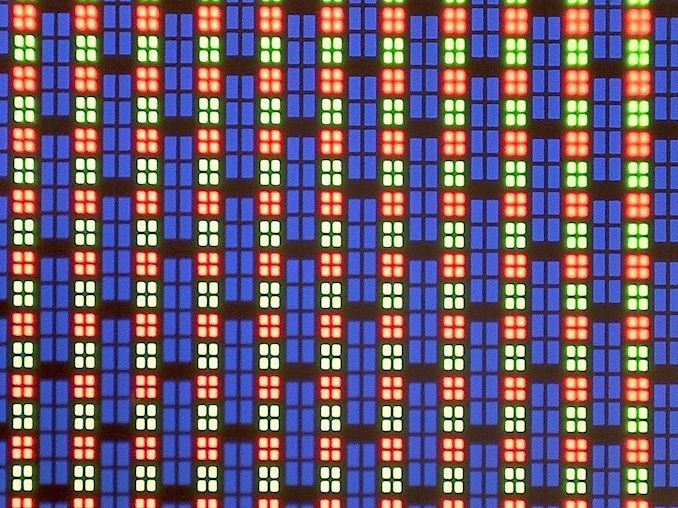













33 Comments
View All Comments
reuthermonkey1 - Monday, March 7, 2022 - link
I do appreciate that they denoted it does not use a USB-C charger, for example.philehidiot - Monday, March 7, 2022 - link
The Linux point is definitely a good one. I am very tempted to put Linux on my next laptop as my old one uses OSX, which I really like over Windows, but hate what Apple do to customers.If a laptop can run a specific Linux distro without excessive hassle, that would be a superb test for me. It has the potential to be a rabbit hole, so I'd suggest something like "n hour Linux install and config test" - set a specific time limit for a competent Linux user and see if they can install a popular distro, and have it configured to run all the hardware properly, within that timeframe.
I also like the proprietary charger idea. That stuff boils my piss.
brucethemoose - Monday, March 7, 2022 - link
Sometimes there's a huge difference between popular distros, usually because they run a really old kernel (Ubuntu/Debian/Mint) and/or don't support proprietary drivers (Nvidia, wifi) ootb (Fedora).And sometimes there are specific community fixes that take seconds to install, but that you might not otherwise know to look for.
Basically, I'm saying this is a tough ask for a reviewer, and such a linux "test" could be very misleading. You are better off diving into the online communities for a particular line/brand yourself.
TheinsanegamerN - Tuesday, March 8, 2022 - link
Basic things, like if it instlals, and if the dual graphics work without hassle, are simple for a reviewer to check with a couple different distros.jospoortvliet - Saturday, March 12, 2022 - link
Just test Ubuntu. Sure there are lots of distros and I personally am not an Ubuntu fan at all but reality is that it just makes sense with its user base and with the aim of keeping it simple.Oxford Guy - Sunday, March 13, 2022 - link
It really is unfortunate how Apple has not chosen to take the high road when it comes to respecting the agency of individual consumers. That is both about its high level of spying and its incessant changing of UI. It’s also about force-feeding people what certain developers there want them to eat — like relentless punishment for using low power mode in iOS.Unfortunate but not at all surprising, since these companies don’t work for ordinary individuals at all. On the contrary…
TheinsanegamerN - Tuesday, March 8, 2022 - link
It's a pain, but barrel chazrgers have two notable advantages: more resistance to force damaging the connector and port, and (IDK if its true on this machine) they can be mounted seperate fromt he botherboard, allowing easy replacement. USB C cant do this.phoenix_rizzen - Monday, March 7, 2022 - link
Would it be possible to run the graphics tests again using the integrated GPU? Would be interesting to see just what the difference is between the iGPU and dGPU. Or is that even possible on AMD-based laptops (I have no experience with laptops that include dGPU)?Could also be interesting to see what (if any) impact switching between the GPUs makes for battery life.
Alistair - Monday, March 7, 2022 - link
no point with ryzen 5000 though, you want ryzen 6000 for thatbrucethemoose - Monday, March 7, 2022 - link
Most laptops are basically unusable on battery with a loaded dGPU, unless its something barely better than an IGP.As for IGP perf, you have to stick to low intensity games on the IGP. Vega 8 is nearly an order of magnitude slower than my 2060, which is somewhat comparable to this 3050.
This is kinda why Ryzen 6000/Van Gogh are so exciting. For the first time ever, gaming on battery may actually be practical.